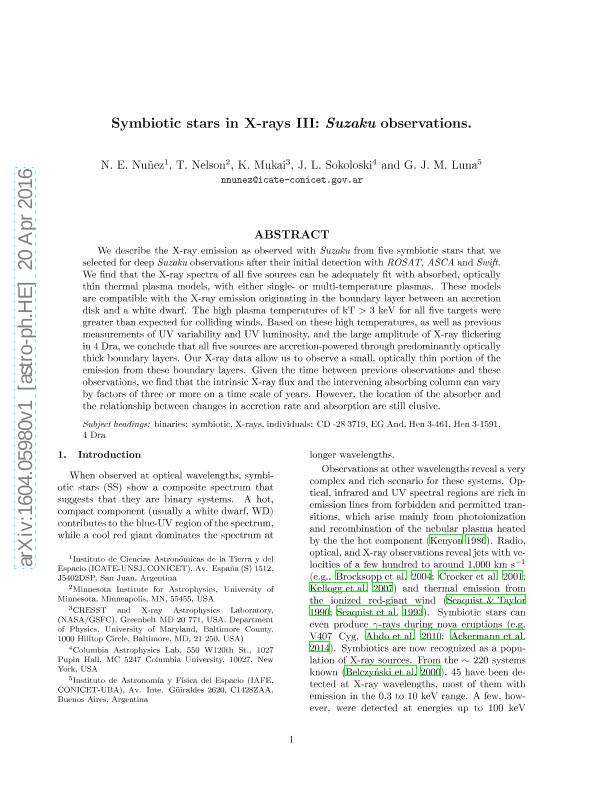Mostrar el registro sencillo del ítem
dc.contributor.author
Nuñez, Natalia Edith

dc.contributor.author
Nelson, T.
dc.contributor.author
Mukai, K.
dc.contributor.author
Sokoloski, J. L.
dc.contributor.author
Luna, Gerardo Juan Manuel

dc.date.available
2017-06-14T18:44:01Z
dc.date.issued
2016-06-07
dc.identifier.citation
Nuñez, Natalia Edith; Nelson, T.; Mukai, K.; Sokoloski, J. L.; Luna, Gerardo Juan Manuel; Symbiotic stars in X-rays III. Suzaku observations; Iop Publishing; Astrophysical Journal; 824; 1; 7-6-2016; 23,1-10
dc.identifier.issn
0004-637X
dc.identifier.uri
http://hdl.handle.net/11336/18181
dc.description.abstract
We describe the X-ray emission as observed by Suzaku from five symbiotic stars that we selected for deep Suzaku observations after their initial detection with ROSAT, ASCA, and Swift. We find that the X-ray spectra of all five sources can be adequately fit with absorbed optically thin thermal plasma models, with either single- or multi-temperature plasmas. These models are compatible with the X-ray emission originating in the boundary layer between an accretion disk and a white dwarf. The high plasma temperatures of kT > 3 keV for all five targets were greater than expected for colliding winds. Based on these high temperatures as well as previous measurements of UV variability and UV luminosity and the large amplitude of X-ray flickering in 4 Dra, we conclude that all five sources are accretion-powered through predominantly optically thick boundary layers. Our X-ray data allow us to observe a small optically thin portion of the emission from these boundary layers. Given the time between previous observations and these observations, we find that the intrinsic X-ray flux and the intervening absorbing column can vary by factors of three or more on a timescale of years. However, the location of the absorber and the relationship between changes in accretion rate and absorption are still elusive.
dc.format
application/pdf
dc.language.iso
eng
dc.publisher
Iop Publishing

dc.rights
info:eu-repo/semantics/openAccess
dc.rights.uri
https://creativecommons.org/licenses/by-nc-sa/2.5/ar/
dc.subject
Binaries: Symbiotic, X-Rays
dc.subject
Individuals: Cd -28 3719, Eg And, Hen 3-461, Hen 3-1591
dc.subject.classification
Astronomía

dc.subject.classification
Ciencias Físicas

dc.subject.classification
CIENCIAS NATURALES Y EXACTAS

dc.title
Symbiotic stars in X-rays III. Suzaku observations
dc.type
info:eu-repo/semantics/article
dc.type
info:ar-repo/semantics/artículo
dc.type
info:eu-repo/semantics/publishedVersion
dc.date.updated
2017-06-13T14:14:19Z
dc.journal.volume
824
dc.journal.number
1
dc.journal.pagination
23,1-10
dc.journal.pais
Reino Unido

dc.journal.ciudad
Londres
dc.description.fil
Fil: Nuñez, Natalia Edith. Consejo Nacional de Investigaciones Científicas y Técnicas. Centro Científico Tecnológico Conicet - San Juan. Instituto de Ciencias Astronómicas, de la Tierra y del Espacio. Universidad Nacional de San Juan. Instituto de Ciencias Astronómicas, de la Tierra y del Espacio; Argentina
dc.description.fil
Fil: Nelson, T.. University Of Minnesota; Estados Unidos
dc.description.fil
Fil: Mukai, K.. University of Maryland; Estados Unidos
dc.description.fil
Fil: Sokoloski, J. L.. Columbia University; Estados Unidos
dc.description.fil
Fil: Luna, Gerardo Juan Manuel. Consejo Nacional de Investigaciónes Científicas y Técnicas. Oficina de Coordinación Administrativa Ciudad Universitaria. Instituto de Astronomía y Física del Espacio. - Universidad de Buenos Aires. Facultad de Ciencias Exactas y Naturales. Instituto de Astronomía y Física del Espacio; Argentina
dc.journal.title
Astrophysical Journal

dc.relation.alternativeid
info:eu-repo/semantics/altIdentifier/ark/http://iopscience.iop.org/article/10.3847/0004-637X/824/1/23/meta
dc.relation.alternativeid
info:eu-repo/semantics/altIdentifier/arxiv/https://arxiv.org/abs/1604.05980
dc.relation.alternativeid
info:eu-repo/semantics/altIdentifier/doi/http://dx.doi.org/10.3847/0004-637X/824/1/23
Archivos asociados
